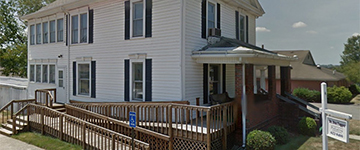Items filtered by date: January 2024
Definitions and Varied Classifications of Clubfoot

Clubfoot, a congenital foot condition, is a complex deformity that affects the structure and positioning of a newborn's foot or feet. This condition is characterized by abnormalities in the tendons, muscles, and bones, resulting in a twisted and abnormally shaped foot. Understanding the classifications of clubfoot is essential for effective management. The first classification, talipes equinovarus, involves the foot turning downward and inward. Talipes varus, the second type, sees the foot turning inward. Talipes valgus, the third classification, features an outward-turning foot. Lastly, talipes calcaneovalgus is characterized by an extended foot turned outward. Each classification poses unique challenges and requires specific treatment approaches. Early intervention is key, often involving gentle manipulation, casting, and sometimes surgical correction. If your child has been born with clubfoot, it is strongly suggested that you are under the care of a podiatrist who can guide you to a comprehensive treatment plan.
Congenital foot problems require immediate attention to avoid future complications. If you have any concerns, contact Dr. Tupper of Coshocton Foot Health Center. Our doctor can provide the care you need to keep you pain-free and on your feet.
Congenital foot problems are deformities affecting the feet, toes, and/or ankles that children are born with. Some of these conditions have a genetic cause while others just happen. Some specific foot ailments that children may be born with include clubfeet, polydactyly/macrodactyly, and cleft foot. There are several other foot anomalies that can occur congenitally. What all of these conditions have in common is that a child may experience difficulty walking or performing everyday activities, as well as trouble finding footwear that fits their foot deformity. Some of these conditions are more serious than others. Consulting with a podiatrist as early as possible will help in properly diagnosing a child’s foot condition while getting the necessary treatment underway.
What are Causes of Congenital Foot Problem?
A congenital foot problem is one that happens to a child at birth. These conditions can be caused by a genetic predisposition, developmental or positional abnormalities during gestation, or with no known cause.
What are Symptoms of Congenital Foot Problems?
Symptoms vary by the congenital condition. Symptoms may consist of the following:
- Clubfoot, where tendons are shortened, bones are shaped differently, and the Achilles tendon is tight, causing the foot to point in and down. It is also possible for the soles of the feet to face each other.
- Polydactyly, which usually consists of a nubbin or small lump of tissue without a bone, a toe that is partially formed but has no joints, or an extra toe.
- Vertical talus, where the talus bone forms in the wrong position causing other bones in the foot to line up improperly, the front of the foot to point up, and the bottom of the foot to stiffen, with no arch, and to curve out.
- Tarsal coalition, when there is an abnormal connection of two or more bones in the foot leading to severe, rigid flatfoot.
- Cleft foot, where there are missing toes, a V-shaped cleft, and other anatomical differences.
- Macrodactyly, when the toes are abnormally large due to overgrowth of the underlying bone or soft tissue.
Treatment and Prevention
While there is nothing one can do to prevent congenital foot problems, raising awareness and receiving neonatal screenings are important. Early detection by taking your child to a podiatrist leads to the best outcome possible.
If you have any questions please feel free to contact our office located in Coshocton, OH . We offer the newest diagnostic tools and technology to treat your foot and ankle needs.
Causes of Athlete's Foot and Ways to Avoid It
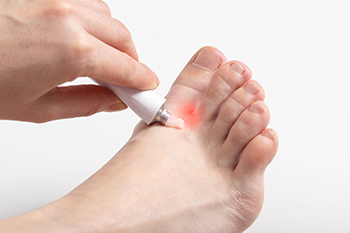
Athlete's foot, a common fungal infection, can cause discomfort and itching, urging us to delve into its origins and effective prevention strategies. This condition thrives in warm, damp environments, making communal spaces like locker rooms, swimming pools, and shared showers breeding grounds. Direct contact with the fungus through contaminated surfaces or by sharing items such as towels and shoes facilitates its spread. Prevention begins with practicing good hygiene, including thorough drying between toes and keeping feet clean. Opting for breathable footwear and moisture-wicking socks helps maintain a dry environment, discouraging fungal growth. Regularly changing socks and allowing shoes to air out are essential habits to practice. Additionally, avoiding walking barefoot in public areas further reduces the risk of exposure. Swift attention to any signs of infection, such as redness or scaling, is pivotal for early intervention. If you have developed athlete’s foot, it is strongly suggested that you confer with a podiatrist who can effectively treat this condition, which may include prescribing medication.
Athlete’s foot is an inconvenient condition that can be easily reduced with the proper treatment. If you have any concerns about your feet and ankles, contact Dr. Tupper from Coshocton Foot Health Center. Our doctor will treat your foot and ankle needs.
Athlete’s Foot: The Sole Story
Athlete's foot, also known as tinea pedis, can be an extremely contagious foot infection. It is commonly contracted in public changing areas and bathrooms, dormitory style living quarters, around locker rooms and public swimming pools, or anywhere your feet often come into contact with other people.
Solutions to Combat Athlete’s Foot
- Hydrate your feet by using lotion
- Exfoliate
- Buff off nails
- Use of anti-fungal products
- Examine your feet and visit your doctor if any suspicious blisters or cuts develop
Athlete’s foot can cause many irritating symptoms such as dry and flaking skin, itching, and redness. Some more severe symptoms can include bleeding and cracked skin, intense itching and burning, and even pain when walking. In the worst cases, Athlete’s foot can cause blistering as well. Speak to your podiatrist for a better understanding of the different causes of Athlete’s foot, as well as help in determining which treatment options are best for you.
If you have any questions please feel free to contact our office located in Coshocton, OH . We offer the newest diagnostic and treatment technologies for all your foot and ankle needs.
Risk Factors for Toenail Fungus
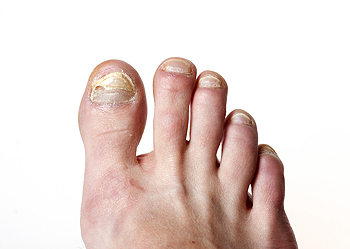
Toenail fungus, a common ailment that affects countless individuals, often finds its way into the lives of those with specific vulnerabilities. One prominent risk factor is compromised nail integrity, often stemming from injuries, cuts, or conditions like athlete's foot. Individuals with a weakened immune system, be it due to medical treatments or underlying health issues, are more susceptible to fungal infections. Poor circulation, a consequence of conditions like diabetes, can also contribute to the onset of toenail fungus. Additionally, lifestyle factors, such as wearing tight or ill-fitting shoes, create an environment conducive to fungal growth. Frequent exposure to warm and damp environments, such as communal showers or swimming pools, heightens the risk. If you have developed toenail fungus, it is suggested that you visit a podiatrist who can offer correct treatment remedies, in addition to providing you with effective prevention methods.
If left untreated, toenail fungus may spread to other toenails, skin, or even fingernails. If you suspect you have toenail fungus it is important to seek treatment right away. For more information about treatment, contact Dr. Tupper of Coshocton Foot Health Center. Our doctor can provide the care you need to keep you pain-free and on your feet.
Symptoms
- Warped or oddly shaped nails
- Yellowish nails
- Loose/separated nail
- Buildup of bits and pieces of nail fragments under the nail
- Brittle, broken, thickened nail
Treatment
If self-care strategies and over-the-counter medications does not help your fungus, your podiatrist may give you a prescription drug instead. Even if you find relief from your toenail fungus symptoms, you may experience a repeat infection in the future.
Prevention
In order to prevent getting toenail fungus in the future, you should always make sure to wash your feet with soap and water. After washing, it is important to dry your feet thoroughly especially in between the toes. When trimming your toenails, be sure to trim straight across instead of in a rounded shape. It is crucial not to cover up discolored nails with nail polish because that will prevent your nail from being able to “breathe”.
In some cases, surgical procedure may be needed to remove the toenail fungus. Consult with your podiatrist about the best treatment options for your case of toenail fungus.
If you have any questions, please feel free to contact our office located in Coshocton, OH . We offer the newest diagnostic and treatment technologies for all your foot care needs.
Recognizing Ankle Fractures
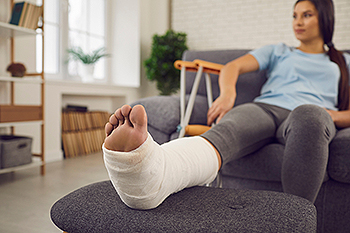
The ankle, which is the junction of the tibia, fibula, and talus bones, is susceptible to fractures that stem from the pounding associated with activities such as running and jumping. Symptoms of an ankle fracture are often similar to those of severe sprains. Individuals may report immediate, intense pain spanning from the foot to the knee, as well as localized swelling, bruising, tenderness, and difficulty in bearing weight. Walking can become painful or impossible. Distinguishing ankle fractures from severe sprains can be complicated. For that reason, diagnostic imaging tests are needed. X-rays, encompassing anteroposterior, lateral, and mortise views play a pivotal role in the diagnostic process. It is also essential to look for secondary fractures, as the presence of one may indicate the possibility of others. In cases requiring a deeper understanding, CT and MRI scans may prove invaluable, particularly for detecting talar fractures and assessing ligament injuries. Early recognition of ankle fracture symptoms and timely medical intervention help to safeguard both immediate and long-term ankle joint health. If you have severely injured your ankle, it is suggested that you schedule an emergency appointment with a podiatrist for a thorough evaluation and precise diagnosis before treatment can begin.
Broken ankles need immediate treatment. If you are seeking treatment, contact Dr. Tupper from Coshocton Foot Health Center. Our doctor can provide the care you need to keep you pain-free and on your feet.
Broken Ankles
A broken ankle is experienced when a person fractures their tibia or fibula in the lower leg and ankle area. Both of these bones are attached at the bottom of the leg and combine to form what we know to be our ankle.
When a physician is referring to a break of the ankle, he or she is usually referring to a break in the area where the tibia and fibula are joined to create our ankle joint. Ankles are more prone to fractures because the ankle is an area that suffers a lot of pressure and stress. There are some obvious signs when a person experiences a fractured ankle, and the following symptoms may be present.
Symptoms of a Fractured Ankle
- Excessive pain when the area is touched or when any pressure is placed on the ankle
- Swelling around the area
- Bruising of the area
- Area appears to be deformed
If you suspect an ankle fracture, it is recommended to seek treatment as soon as possible. The sooner you have your podiatrist diagnose the fracture, the quicker you’ll be on the way towards recovery.
If you have any questions, please feel free to contact our office located in Coshocton, OH . We offer the newest diagnostic and treatment technologies for all your foot care needs.
Various Risk Factors for Foot Neuropathy
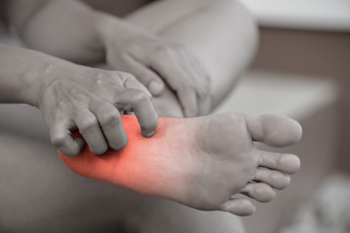
Foot neuropathy, characterized by nerve damage in the feet, can be influenced by various risk factors. Diabetes stands as a primary risk factor, as prolonged high blood sugar levels can lead to nerve damage, causing sensory disturbances in the feet. Alcohol abuse is another significant factor, as excessive alcohol consumption can harm nerves and contribute to neuropathy in the feet. Vitamin deficiencies, particularly B vitamins, may also increase the risk of foot neuropathy. Certain medications, such as chemotherapy drugs and those used to treat HIV, can have neuropathy as a side effect. Physical trauma, repetitive stress, or injuries to the feet can damage nerves and lead to neuropathy. Autoimmune diseases such as rheumatoid arthritis and lupus may trigger autoimmune responses that damage nerves in the feet. Hereditary factors, including a family history of neuropathy, could elevate the risk. Awareness of these diverse risk factors is vital for early detection and prevention of foot neuropathy. If you suffer from this condition, it is suggested that you schedule an appointment with a podiatrist for an examination and appropriate treatment.
Neuropathy
Neuropathy can be a potentially serious condition, especially if it is left undiagnosed. If you have any concerns that you may be experiencing nerve loss in your feet, consult with Dr. Tupper from Coshocton Foot Health Center. Our doctor will assess your condition and provide you with quality foot and ankle treatment for neuropathy.
What Is Neuropathy?
Neuropathy is a condition that leads to damage to the nerves in the body. Peripheral neuropathy, or neuropathy that affects your peripheral nervous system, usually occurs in the feet. Neuropathy can be triggered by a number of different causes. Such causes include diabetes, infections, cancers, disorders, and toxic substances.
Symptoms of Neuropathy Include:
- Numbness
- Sensation loss
- Prickling and tingling sensations
- Throbbing, freezing, burning pains
- Muscle weakness
Those with diabetes are at serious risk due to being unable to feel an ulcer on their feet. Diabetics usually also suffer from poor blood circulation. This can lead to the wound not healing, infections occurring, and the limb may have to be amputated.
Treatment
To treat neuropathy in the foot, podiatrists will first diagnose the cause of the neuropathy. Figuring out the underlying cause of the neuropathy will allow the podiatrist to prescribe the best treatment, whether it be caused by diabetes, toxic substance exposure, infection, etc. If the nerve has not died, then it’s possible that sensation may be able to return to the foot.
Pain medication may be issued for pain. Electrical nerve stimulation can be used to stimulate nerves. If the neuropathy is caused from pressure on the nerves, then surgery may be necessary.
If you have any questions, please feel free to contact our office located in Coshocton, OH . We offer the newest diagnostic and treatment technologies for all your foot care needs.

